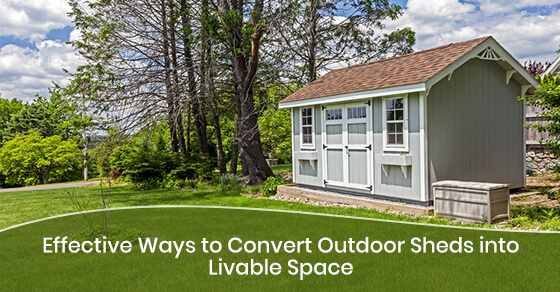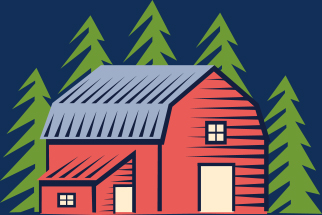Effective Ways to Convert Outdoor Sheds into Livable Space
Posted By Cathy Scholes On 04-02-2019

Your outdoor shed is not just a place to store garden tools and seasonal items. It is one of the most versatile spaces in your home, one that can be designed to create a functional and attractive living space for a growing household, or for many other purposes.
With a firm base, damp-proofing, power, ventilation, and a heating system, your outdoor shed can be transformed into a safe and cozy room that can be used as a home office, music room, or anything else that you need extra space for.
If you’re looking to make better use of your unused shed at your backyard, there are several ways you can customize the structure to create a homely space while enhancing the beauty of your backyard. Here are a few suggestions to help you make the most out of your shed:
Planning: Uses, Requirements, Permits
Before starting any work on your outdoor shed, you should first evaluate its current condition, including the foundation and walls, to ensure that you’re working on a strong and stable structure that will last for years. Make any necessary repairs, and move the shed to better ground if needed.
Next, determine what the space will be used for, and then identify the items needed to fulfil that function. For instance, the design and furniture for a home office will be different from that needed for a man cave or workshop.
You should also find out if there are any permits required for building or renovating a detached residential structure in your area. You will likely need:
- A building permit for a shed covering an area of more than 10 square metres and that is habitable
- A development permit
- Electrical, plumbing, HVAC, and gas permits as required
When making your application for these permits, you should provide copies of your site plan, building plan, and the names of any contractors that you’ll be working with. Please consult your local authorities for the proper standards and legal requirements in your area.
Damp-proofing
Damp conditions often lead to rot, mould, and decay. It is usually caused by leaks in your roof, walls, or plumbing system, rising damp, poor air circulation, and condensation or morning dew. If your shed is damp, there are a few measures you can take to correct the problem, including:
- Insulating the floor, walls, and roof
- Fixing any leaks
- Installing a damp-proof membrane before adding a concrete floor
- Applying an insulating vapour barrier or breathable membrane to the walls
- Improving air circulation around the exterior of the shed by cutting down any bushes
- Applying wood preservative
- Installing permanent and trickle ventilation to allow for air circulation
Insulation
Before starting any work, inspect the walls, roof, windows and doors of your shed for cracks, and seal any that you find up. You may also need to break out the caulk and weatherstripping to make your shed airtight and prevent vermin from making a home in your shed, and cold draughts stopping you enjoying the space.
Insulating the walls, floor, ceiling, and doors and windows will help to ensure that your new space is sufficiently warm and damp-free. It can also help to keep noise out so you can enjoy some peace and quiet or contain it if you’re converting the shed into a workshop that will have loud machinery, so you don’t disturb your family and neighbours. Here’re your options:
- Wall insulation
There are several materials you can use to insulate your walls, including:
- Foil-coated bubble wrap, which is a simple and budget-friendly insulation option
- Fibreglass and mineral wool or ‘Rockwool’, which has good thermal insulation and soundproofing properties
- Foam insulation boards offer great thermal insulation for both walls and floors but are very expensive
- Floor Insulation
Depending on the size of your budget, you can install foam insulation boards on your floor. Alternatively, you can use a breathable membrane and top it with durable flooring, rug, or carpet off-cut. The membrane will prevent any underground moisture from penetrating into your shed.
- Ceiling Protection
There are two common options for protecting your ceiling. You can use the same glass and mineral wool material used on your walls, or natural insulation like hemp or sheep’s wool. Both options are sustainable, flexible, and easy to install, plus they’re breathable, which makes them effective for damp prevention. Remember to leave some space between the roof and insulation for air circulation and to allow moisture to escape.
- Doors and windows
After insulating your walls and ceiling, you can add weather stripping to the windows and doors by:
- Applying weatherproofing plastic to windows.
- Adding caulk to draughty areas in the window
- Using sealing foam tape on the window bottom panel
- Using a door draught blocker under your shed door
Lighting
It is best to maximize natural lighting during the day. Installing skylights and windows will not only brighten your space and reduce lighting, heating, and cooling costs, but also facilitate air circulation and ventilation for optimal comfort.
For additional lighting, consider:
- LED lighting
- Halogen spotlights and moving track lights
- Fluorescent overheads
Decorating Your Shed
Adding a fresh coat of paint inside your shed will instantly brighten the space. White paint, for instance, will improve lighting for a workshop. You can also hang pictures, posters, and other decorations to make your new space suit its purpose. Make sure to coat the exterior with wood treatment or paint. You could also add plants, such as vines that will crawl up the outside walls and make the shed fit in better with the landscape.
Security
With your shed upgraded and now an eye-catching fixture in your yard, it will become an attractive target for thieves and intruders, especially if there are no obvious security measures. You should keep the shed door closed when not in use, invest in quality locks, and improve the security around your home and shed to deter intruders.
Here are some ways to improve outdoor shed security and keep your valuables safe:
- Make it difficult for strangers to access your backyard
- Consider installing laminated glass that won’t smash when hit with a brick or hammer.
- Use blinds or curtains to hide your valuables to deter opportunistic break-ins.
- Secure small valuables in secure cabinets or lock them to the floor
- Replace your standard shed door with a more secure, framed door with a secure lock
- Consider installing a burglar alarm, including motion-sensitive outdoor security lights
Final Note
With careful planning, you can transform an old outdoor shed into your favourite living space. Make sure to add the right furniture for the shed’s purpose and use vertical storage to keep garden items and other tools. You can also install any essential amenities, including electricity, water, and heating and cooling to make it functional year round.
For more information about transforming your shed, call In the Back Yard today at +1 813-242-2780 or contact us here.
 0 Comment
0 Comment

